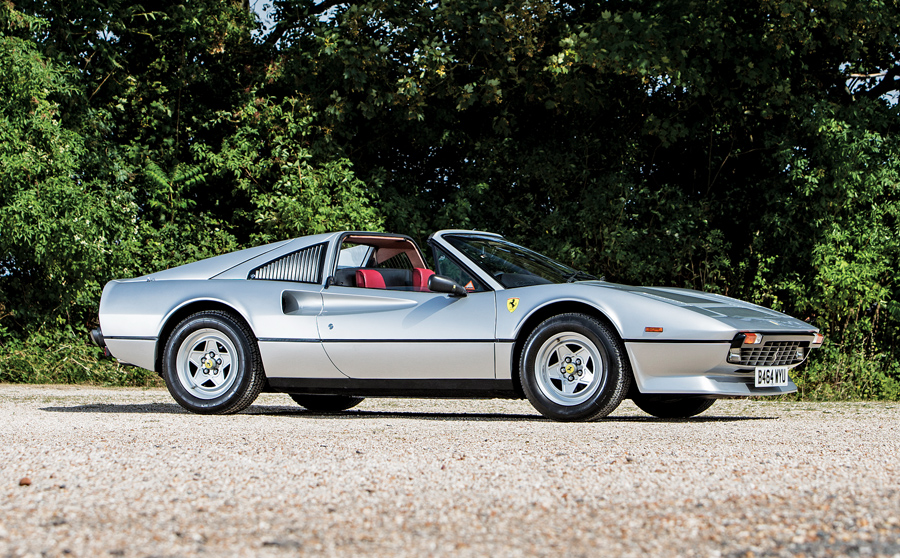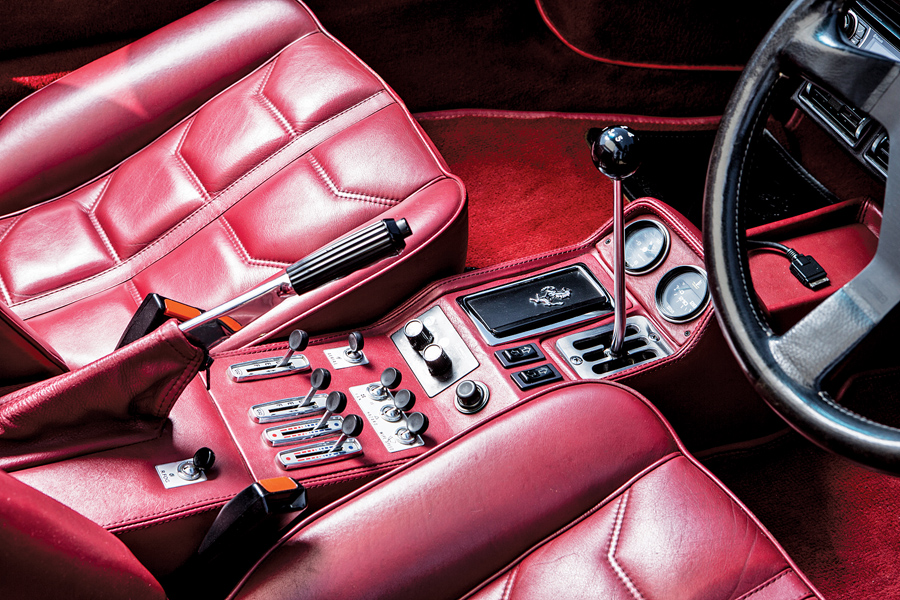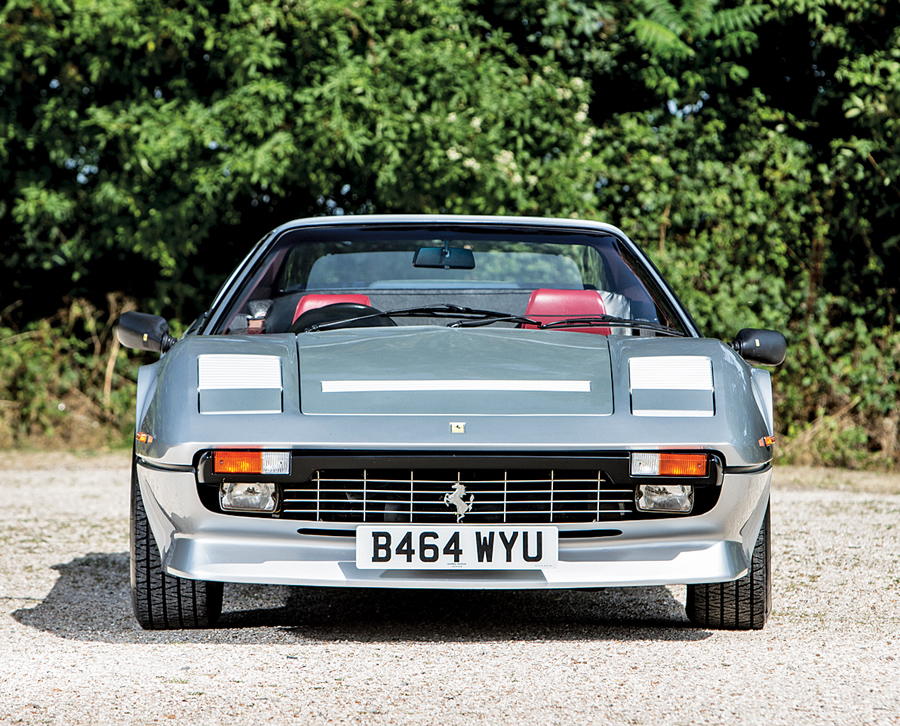SCM Analysis
Detailing
| Vehicle: | 1984 Ferrari 308 GTS QV Targa |
| Years Produced: | 1983–85 |
| Number Produced: | 3,045 |
| Original List Price: | $56,250 |
| SCM Valuation: | $62,500 |
| Tune Up Cost: | $3,500 |
| Chassis Number Location: | Top frame rail, right side of engine compartment |
| Engine Number Location: | In the V of the block on the distributor side |
| Club Info: | Ferrari Club of America |
| Website: | http://www.Ferrariclubofamerica.org |
| Alternatives: | 1984 Porsche 911, 1984 Lamborghini Jalpa, 1984 Lotus Turbo Esprit |
| Investment Grade: | C |
This car, Lot 254, sold for $84,133, including buyer’s premium, at Bonhams’ Goodwood Revival Sale, Chichester, U.K., on September 8, 2018.
There can be a lot of argument for the 308 series being the catalyst for making Ferrari the powerhouse it is today. It was an immensely popular series that crossed Ferrari over from a small manufacturer of ultra-expensive, high-performance Grand Touring and race cars to a purveyor of sports cars that were affordable to the merely well-off enthusiast.
The 308’s build quality was excellent, and their fun factor was high. They were a great value at the time and remain a great value today.
The long history of Ferrari 308 cars
The first 308 was introduced in 1974 as the Dino 308 GT4.
Chronologically the GT4 replaced the 246 Dino, and like the 246, it was badged as a Dino rather than a Ferrari. Other than the mid-engine configuration and the name, the 246 and 308 Dinos were very different cars.
The 246 was powered with an adequate-but-small 2.4-liter V6, while the 308 GT4 housed a robust and torquey 3-liter V8.
The curvy Dino 246 was a 2-place model designed by Pininfarina, and it is universally appreciated as one of the most beautiful cars ever built. On the other hand, the 308 GT4 was a 2+2 model designed by Bertone in the angular fashion popular at the time.
The GT4 didn’t win any design awards, but it was attractive, and its appeal has improved with age. It was the inside of the GT4 that made the car special. The interior was spacious and comfortable. The forward visibility is panoramic, with rearward visibility that rivals all mid-engine cars. The 3-liter engine was quite responsive and had enough torque to allow spirited driving. The engine sound was intoxicating, encouraging driving in a lower gear and higher rpm than necessary.
Anyone who spent time in a 308 GT4 will fondly remember the experience. Recalling pleasant memories, SCM Publisher Keith Martin recently set back his clock 30-some years with a purchase of a GT4 for the SCM fleet.
A new Pininfarina design inspires lust
The 308 GT4 was re-christened a Ferrari in 1976, and a second Ferrari 308 model was added to the line that same year. The new model, the Ferrari 308 GTB, was a 2-place mid-engine coupe of Pininfarina design that inspired lust like few other cars in automobile history. It was modern but not over the top, it was edgy — but still beautiful. It was elegant yet sporty.
If you saw one, you wanted one.
Under the skin, the 308 GTB was basically a 308 GT4. It still featured a transverse-mounted V8 sitting on top of a 5-speed transaxle. The chassis was a ladder design built of strong oval steel tubes. The suspension is independent all around. The brakes were power-assisted four-wheel discs. All the great driving attributes of the GT4 could be found in the GTB — minus some comfort and visibility.
308 GTB production would run through 1985. A similar but larger-engine version of the 308 was introduced in 1986. The new 328 would finish out the 308’s run, with the substantially different 348 series replacing the 328 in 1989.
Ferrari would produce several variations of the 308 during its production run. The GT4 was the 2+2 model, the GTB was the coupe, and the GTS was the Targa roof model. The Mondial 8 replaced the GT4 as the 2+2 model in 1980, but it did not carry the 308 name.
Fuel injection and lots of valves
The original 308s featured four 2-barrel Weber carburetors.
The engine looked, sounded and drove impressively, but it was difficult to make it meet U.S. emissions regulations. In 1980, a fuel-injected version of the 308 was introduced. A small “i”, as in 308 GTBi, followed the model name to identify it as having the fuel-injected engine.
The “i” models lacked the performance necessary to compete with their contemporaries, so an upgraded 4-valve-per-cylinder —Quattrovalvole — version of the 308 engine was introduced in 1983.
The Quattrovalvole’s engine was a dramatic improvement over the i models. Horsepower was way up and so was torque. Modern acrylic enamel paint introduced on the later i models was continued on the Quattrovalvoles.
In the U.S., 16-inch wheels were fitted on all but the earliest QVs. U.S. cars also got a new interior, a roof spoiler, new mirrors and a vent in the hood. Upgrades varied in non-U.S. markets.
Reliable Ferrari fun at a bargain price
I sold 308s when they were new, and I still sell a couple of used ones a year. I recently spent a good portion of a day driving a 308 GTB in a rally, and I put an hour on a 308 GTS QV while researching this profile. I know these cars well, and I like them a lot. It isn’t fair to compare a 308’s performance to most modern sports cars. However, the 308 has a better driving experience.
The 308 interior is spartan and purposeful. The steering is manual, as are most of the controls and the gearbox. There’s no question who’s in charge. From the transmission to the a/c, nothing happens without your input.
When you do add your input, everything feels right. The virtue of a 308 is its lack of flaws. The steering, brakes, throttle, engine and suspension are not incrementally better than other sports cars of the era — but when they are added together, the 308 is truly a superior car.
Driving the 308 QV down familiar streets, bumps that are noticeable in other cars disappeared — not a trait you’d expect in a sports car. The clutch operates smoothly, without chatter or herculean effort. Shifting gears via the gated shifter is a joy, as shifts are smooth and precise.
The 308 Quattrovalvole turned 35 years old this year. In a testimony to the model’s engineering and build quality, it seems the majority of the cars are still around.
While high mileage substantially hurts value, well-maintained examples seem to go forever. Finding an example with original paint should not be hard. Minor paintwork is prevalent and should not be a deterrent. Leather and carpet are weak links. Lighter colors fade and show wear.
Our subject 308 QV
Bonhams’ Quattrovalvole appears to be a well-kept example in a sharp color combination. It was represented as having its original books and tools — along with a comprehensive service file. In all the bragging about service records, the date of the last major service wasn’t mentioned. That major service can run from $1,500 to $5,000.
The sale price was a big number, but with just 184 RHD GTS Quattrovalvoles produced, there are few examples for buyers to choose from.
The mileage checked in at a little over 46,000 miles, which should appeal to all. The buyer could have saved a little money on the private market — but she or he didn’t get hurt paying up for a great car. ♦
(Introductory description courtesy of Bonhams.)


